Many of my previous forty blog posts have delved into identifying habits or behaviors that keep us stuck and prevent us from moving forward. While many of my Body Results clients have specific outdoor goals they are pursuing, some ask me specific nutrition questions such as, “What should I eat?” or “Can you design a diet plan for me?” The answers are as diverse as the people asking them. My first suggestion is to focus on your eating habits. In other words, first focus on how to eat, not what to eat.
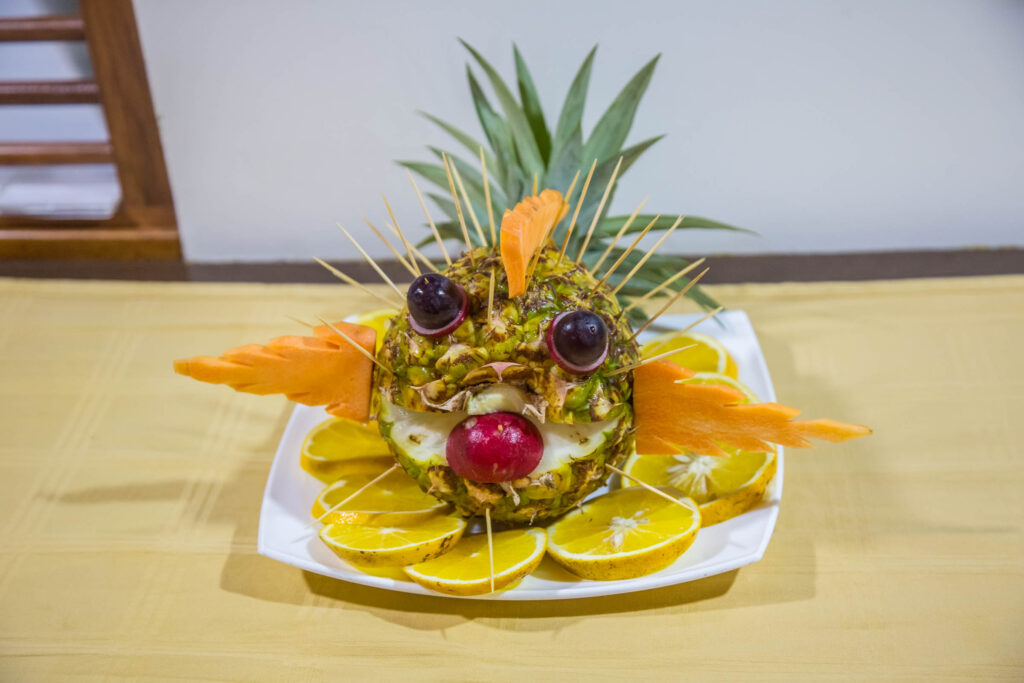
The Eating Habits
Before learning about the habits, please pick only ONE to play with over the next week to ten days. Trying to do them all at once will dilute your efforts and set you up for frustration and failure. I have been coaching nutrition change for about seven years now and I am still working on mastering the habits. But awareness is half the battle. Pat yourself on the back for wanting to change and then find someone who can help point out when you are making the change and when you have slipped into previous habits.
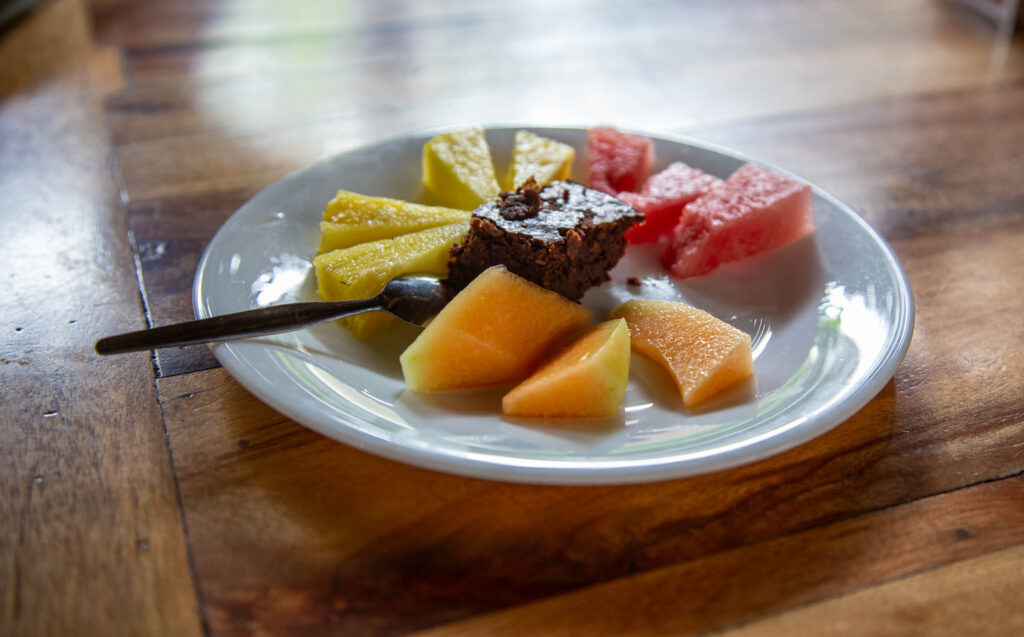
Between Meals
The following practices are suggestions to try before you ever take a bite.
- Listen to your body’s signals for hunger. Legitimate hunger may cue you by rumbling or gurgling in your stomach. If you feel lightheaded, you may be low in blood sugar. A touch of a headache could mean either dehydration or a need for nourishment. Pay attention to your body’s cues. It is very smart. By learning what your unique physical hunger signals are, you can start to distinguish them from emotional cues.
- Avoid multi-tasking at mealtime. Your goal when you eat should be to enjoy, savor, and taste your food. That is difficult to do if you are numbing yourself in front of the television, reading, scrolling through messages or cat videos on your phone, feeding the kids, driving, etc. If you are doing anything else, put off eating until you can focus on just eating.
As You Prepare a Meal
As you get ready to have a snack or meal, consider the following habits.

- Make it a meal. Set the table with a bowl or plate, fork or spoon, placemat, and a napkin (even if it’s paper rather than cloth) in full view of whoever is in your household. NOT in the car. NOT standing in front of the open refrigerator. And definitely NOT hiding in a closet or bathroom or in the basement at oh-dark-thirty after everyone has gone to sleep.
- Help your body rest and digest. As you get ready to sit down meal, take a deep breath, hold for a second, sip in a little more air, then slowly release to a count of eight. Do that “sipping breath” three times before you ever take a bite. Doing so creates open-regulation for the vagal nerve so that your body is in a “rest-and-digest” state rather than “fight-or-flight.” Even the most nutritious of meals will do absolutely no good if you are eating it in the car, dashing between appointments, with three screaming kids in the back seat. Nobody can digest a meal like that!

Slow Down During a Meal
Once you are legitimately hungry, focused, sitting at the table, and calm, you are ready to actually eat.
- Chew thoroughly. This practice does not apply if you are consuming Gu packs at altitude on the mountain (Gu is designed for consumption when you do NOT feel up for chewing) or if you have some physical problem like dental work or a jaw wired shut, or if you have to be on a liquid diet. Otherwise, to start the digestive process, we need to chew our food well. The next bite you take, try chewing forty times before you swallow. Then think about what that experience was like. You can bet it will slow you down!
- Set your spoon or fork down between bites. This is another great strategy for slowing down and allowing your body and mouth to enjoy your meal. This also gives you time to have a conversation with someone at your table instead of constantly shoveling food into your mouth.
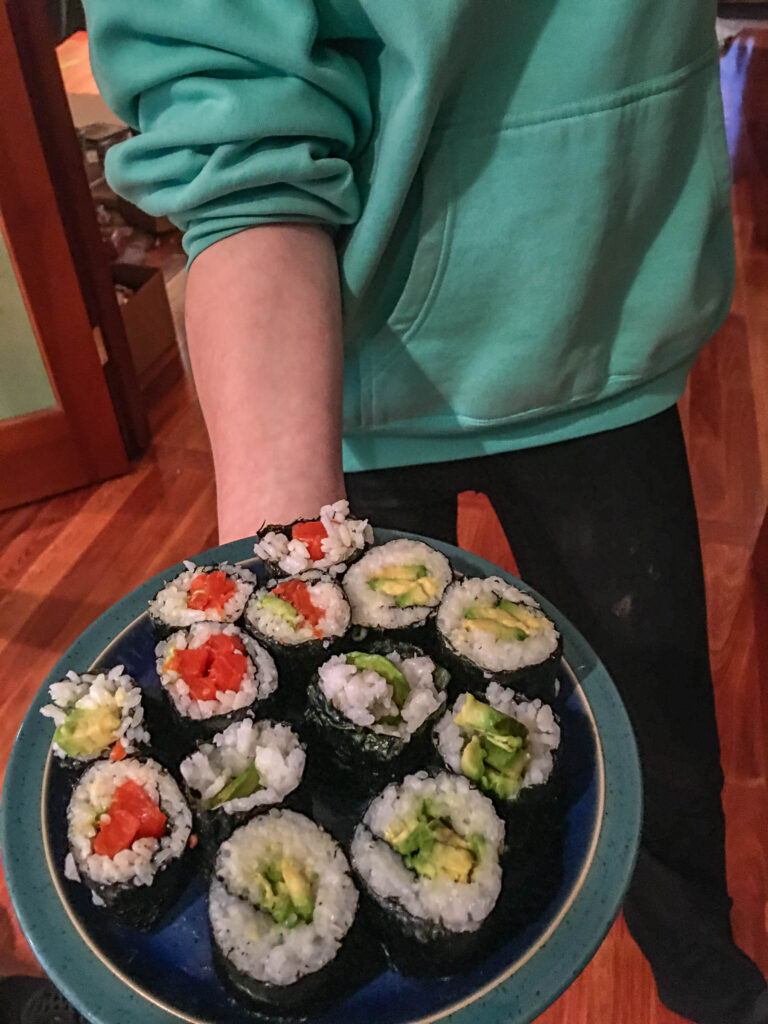
- Eat with your non-dominant hand. Since breaking my wrist in February I have had a lot of experience with this one. Now that I am trying to eat with my right hand again, I sometimes have trouble cutting with a knife and cannot fully supinate (turn the palm up) which makes using a fork tricky. But it is improving.
Keep Your Table a Guilt-free Zone
ENJOY and SAVOR your food without guilt or shame. If you really want that pint of Ben and Jerry’s ice cream, have it. Just be sure to grab a chair, sit down with a bowl, placemat, spoon, and napkin. Light a candle. If there are any cookie dough chunks, chew them forty times. Set the spoon down between bites. Guilt has no place at the dining table and will only add to your stress.
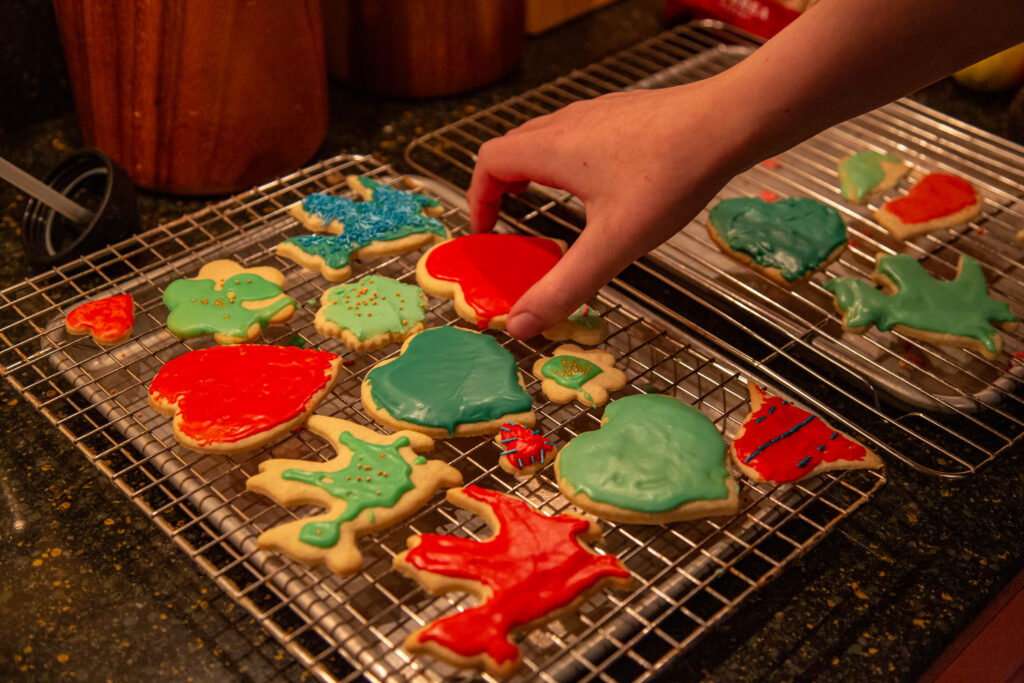
Eating Habits After a Meal
- Hydrate between meals rather than during. In order to properly digest your food, experiment with liquid consumption outside of mealtime. Digestive enzymes help you digest your food properly; water dilutes these enzymes and might cause sub-optimal utilization of the nutrients you are trying to supply.
- Learn to recognize your “satiation sigh.” Your body signals when you have had enough, usually at about 80% full. You will experience a deep sigh of satisfaction which means “stop.” The trouble is, the faster we eat, and the more unaware we are of what we’re eating, the less likely we will hear our body’s request to stop. Most people who multi-task around mealtime or power-eat in five minutes may not even recognize the signal, then wonder why the heck they are so full.
- Leave some for later. The great thing about modern refrigeration is we can always save part of our meal. My daughter and I always order more pizza than we can eat in a single sitting, so we have leftovers for breakfast and sometimes lunch. Bonus!
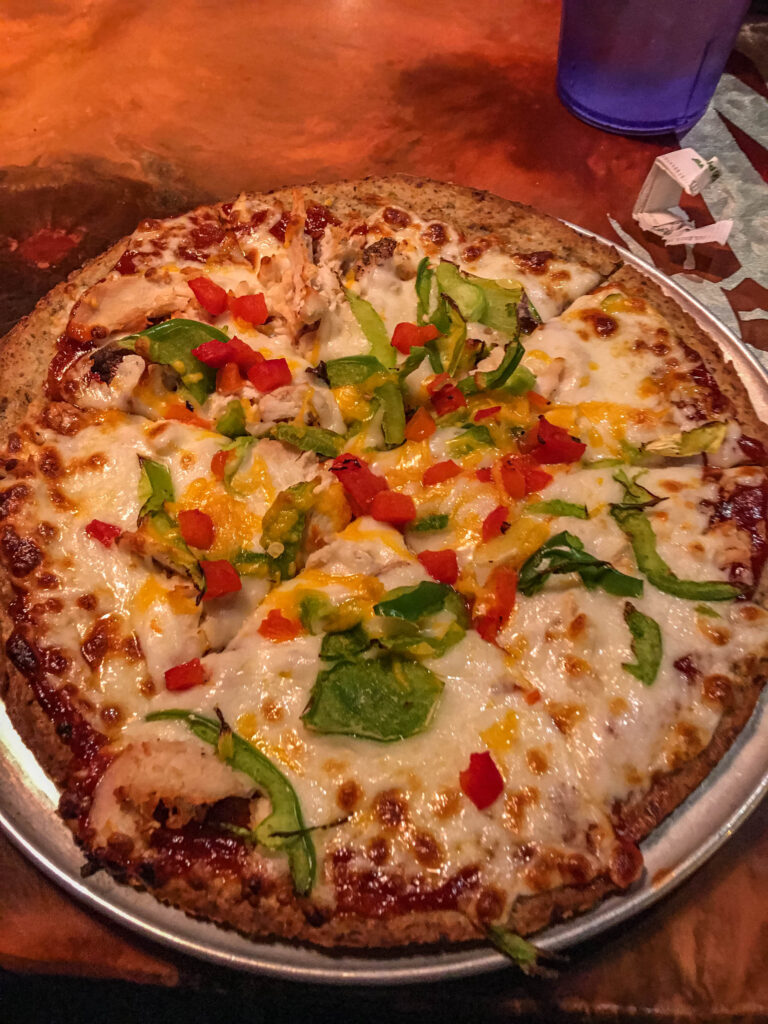
Next Step: Choose Which Eating Habits to Change
Remember, these are only starting points. We are all works in progress and we have had decades to engrain our habits. Be gentle with yourself as you try to change them.
One way to choose which to focus on is by recognizing how you reacted when you first read them. If you scoffed and said, “Well that’s impossible,” you’re probably right. For now. If your reaction was, “Ooh, maybe I could try that,” put it at the top of your list. For any that seem challenging but not impossible, hold them as options for the future.
Give yourself a good week to ten days to experiment with one. If it isn’t something that works for you, try another one. Maybe you can revisit it in the future. And remember, nobody expects perfection. Remember the new year’s post on KISAGE? Keep it simple and good enough. Pick one. Gamify. Make it fun. Learn from it. And if after ten days you notice a difference in how you’re eating, try experimenting with another.

As always I love to hear what you’re learning about yourself in the comments. Feel free to share your experiences so we can all grow and learn together.


Great comments all Court, thanks for stating a FEW (I liked that) simple (uncomplicated, not simplistic) things to focus on whilst eating to improve our nutrition. As you know, I alive alone so that means I have to both cook everything myself (already tried some meal plans, taste no bueno AND still have to cook the stuff) and, eat alone. Very hard to “savor” food and the experience, which is, I know, a good thing to do, when I’m tired of cooking and there’s never anyone with whom to share the food experience…ever. I believe that eating is and should be a communal experience, at least some of the time. As humans, we use that time to bond and enjoy the fruits of our labors. I also know and agree that reading a book or looking at cat videos is at cross-purposes with savoring and appreciating the food but I can only stare at my dining room walls just so many times before I, well, go off to eat a protein bar. Anyone have any ideas? Thanks, I’m always interested. 🙂
Sara, you bring up such an important point: living alone. I have a daughter and husband so I cannot relate to your experience NOW, but when I was in grad school I ate alone a lot and that is where my dysfunctional eating habits actually began. I would love to hear from others about their experiences but a few thoughts I had were around MOVING THE NOTCH ONE BETTER — meaning, can you ONCE A WEEK plan on a meal with a friend or loved one? Can you plan to take your meal as say a picnic to a beautiful place that sparks joy? Can you join a group where once a month people gather for food and conversation i.e. maybe an art club, book club, something you all have in common? It doesn’t solve the “every day” problem but even a FEW such meals where you have something to look forward to, socialize, and not always eat alone can provide sparks in other areas of your life as well. Just some ideas.
Hi Sara and Courtenay,
I have lived alone for a long time and own the habit of eating my dinner in front of the TV where I will always over eat. ‘Make it a Meal’ is the new habit that I plan to work on.
I have some ideas but haven’t tried them yet. I am going to move some of my evening meals to my outdoor balcony that over looks a couple of neighbor’s yards. There is often activity around to keep me company during dinner, whether it be children playing or birds flitting around in the trees. The next idea is going to sound insane but I am going to put it all out there. During the pandemic lock-down I took to talking to my large stuffed Eeyore. I wonder what it would be like to have him sit at the table with me for dinner? He is great company and rarely argues my points. I plan on setting up some pictures of loved ones on the dinner table to see how that feels.
I have tried taking meals to my work meetings, all audio, to have company while I eat. The problem I have with that is that I will stop when I am 80% full and set the plate with the leftovers on my desk to take to the kitchen once the meeting is over. This leads to me grazing on the rest of the meal during the meeting. It might work better if I put less food on my plate to begin with. That would force me to wait until after the meeting before going back for more food which will give my tummy time to realize it is full.
Courtenay mentions moving the notch one better by doing one small thing. There is an old habit that I have started again now that the pandemic restrictions have loosened. Once a week, I take a meal at a local restaurant that has a bar with comfortable stools. I like the bar because sitting alone at a table feels awkward to me. Once a week is often enough to be a ‘regular’ and get a little special treatment. The place I go to is a steak + fish and chips type of bar and I am a vegetarian. They make me a plate of grilled veggies with a side of mashed potatoes. They always have the same bartender and he will chat with me as time allows. The place always has the chatter of other people too. This helps me get my social experience and I feel more at peace during the rest of the week with my home-alone meals.
Pen
Pen, these are fabulous, creative ideas. Especially adding pictures of family members — that feeds into the concept of gratitude, being thankful for and appreciative of those you love who have supported you in the past. And going to a place where you feel a sense of community reminds me of the sitcom, Cheers, where “everybody knows your name.” And you are absolutely on point when you say it doesn’t have to be every meal, once a week for the bar, a few nights on the balcony, the occasional picnic — these can break up the monotony and get you thinking about even more ways to help yourself. Such great thinking.
I am eager to hear more about your experiences with a comfort stuffy. When my previous dog died in 2012 after 12.5 years of shadowing me everywhere, I got a large stuffed panda and would cuddle with it instead of my dog. I still have it.
Food and mealtime both tie in so closely to family — whether stressful or comforting — that creating that sense of togetherness, comfort, solace, and community is important, especially for those living alone. Finally, knowing that you are NOT alone, that there are others going through something similar, makes us feel that much better, like we are not the only ones on this planet experiencing what we are experiencing.
Kristin Neff talks about developing self-compassion and our “common humanity” as human beings — might be worth a read. Thanks so much for the ideas! One of the reasons I created this blog is for an open exchange of ideas beyond my own and this is a great illustration of readers helping readers. Much appreciated.
Court and Pen – the ideas you both have put out are terrific!!! I’m set to give one or two of them a try but most of all, I really appreciate your (both) thoughtfulness in coming up with some great suggestions! Sara
Certainly, Sara! I hope some of them help. Keep reading and keep asking great questions!